Marketing automation has a ton of applications.
Maybe you want to use it to put relevant content in front of potential customers to increase engagement and gain new subscribers.
Maybe you want to use email marketing automation to send welcome emails, abandoned cart emails, and other messages at the times that work best for generating engagement.
Or maybe you just want to eliminate repetitive tasks so your team can focus more wholly on their campaigns.
Whatever the reason, embracing marketing automation and using the best marketing automation tools can help you make that happen.
The question is, “What will your marketing automation workflows look like?”
11 Marketing Automation Workflows and How to Set Them Up
There may be unlimited possibilities in the world of marketing automation workflows, but it can still be very helpful to take a look at some common examples. After all, companies use these workflows for a reason: they work!
- Welcome Email Nurture Workflow - Create quick rapport with new subscribers and nudge them to take further actions.
- Customer Service Workflow - Streamline customer service by enabling customers to resolve many of their own issues and equipping reps with critical information for escalated cases.
- Churn Prevention/Re-engagement Workflow - Proactively target at-risk customers and get them to re-engage before they’re lost.
- Cart Abandonment Workflow - Prompt customers who have abandoned their carts to return to your site and complete the transaction.
- Survey Workflow - Trigger customer surveys after meaningful interactions.
- Incentivization Workflow - Automatically provide customers who need an extra push with an incentive to buy through special offers or discounts.
- Gated Content Workflow - Prompt leads to provide their email in exchange for gated content like a whitepaper or industry report.
- Recommendation Workflow - Provide existing customers with product recommendations based on prior purchases.
- Subscription Renewal Workflow - Let customers know their subscription will soon be ending to encourage renewal.
- Lead Scoring Workflow - Automatically assign leads scores based on actions like signing up to an email list or downloading gated content.
- Communication Workflow - Facilitate smoother communication between sales and marketing by automatically sending relevant data.
1. Welcome Email Nurture Workflow
Welcome email nurture sequences are one of the most popular and effective engagement workflows, keeping new signups in your sales funnel and feeding them automated emails with relevant content to their interests.
At its simplest, this email marketing workflow can consist of a single trigger and a single action. The user provides their email address, and the system sends an automated email to welcome them and provide some additional information.
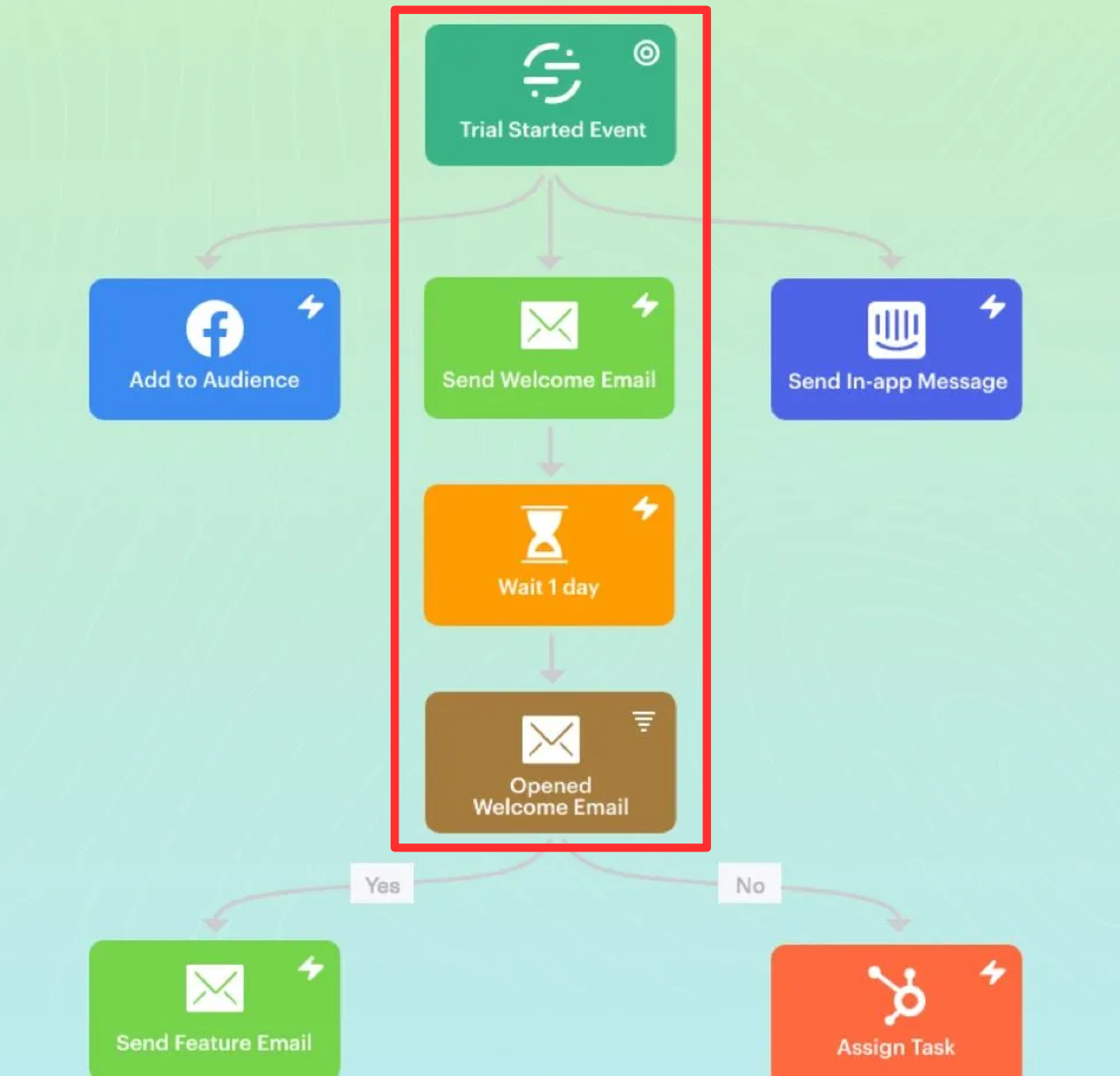 Image Source: Encharge
Image Source: Encharge
However, the best practice here is to construct an automated workflow that’s a bit more sophisticated.
An automated email workflow like this might start with a signup and a welcome email, but it can lead to a nurturing workflow where additional automated emails are sent based on additional triggers such as user-product interactions or email engagement.
For example, a B2B technology company might send an automated welcome email to all the new signups encouraging them to try their free software tier.
Users who log into the software within the first 24 hours are then entered into an email workflow that feeds them helpful how-to information in order to ensure they’re successful with the product.
Users who don’t log into the software during that time are funneled into a different email workflow with automated emails designed to get them to engage, perhaps by sharing user testimonials or offering an incentive for trying the software.
Although simple on the surface, this kind of email marketing workflow can become quite complex, with users moving into different email workflows to encourage different actions based on their activity (or inactivity).
2. Customer Service Workflow
Customer service workflows can serve a variety of purposes, but one of the most common is to reduce the burden on support staff by making it easier for customers to resolve their own issues.
The trigger for one kind of customer service workflow could be a direct request for help, such as a customer emailing a support email address, mentioning a support account on social media, or filling out a support ticket.
It could work like this: the customer receives an automated email reply, telling them that their request has been received and will be reviewed by an agent. This email might also provide some suggestions for how customers can resolve common issues themselves.
At the same time, the marketing automation tool automatically adds the customer’s request into the support ticketing software’s queue.
Also Read: Marketing Automation Examples
When a human agent opens the ticket, they can be provided with a pre-written response they can use that is based on the content of the customer’s ticket.
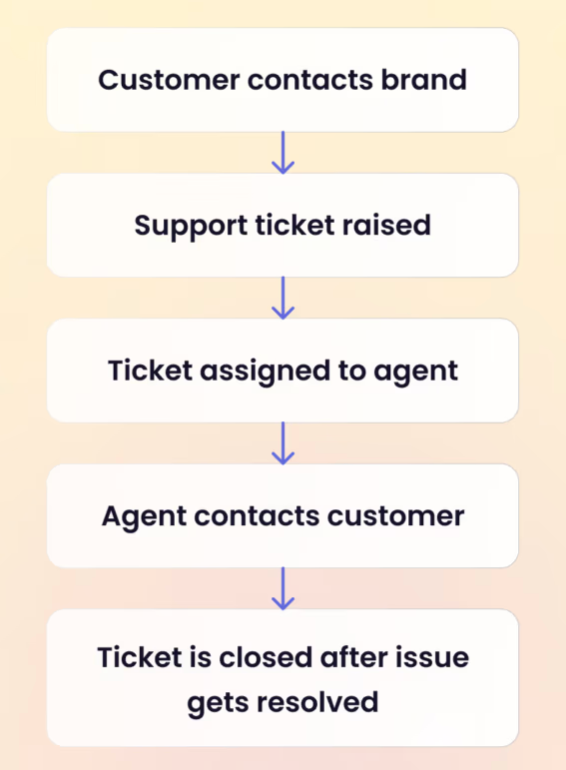
Image Source: Hiver
However, there’s also another sort of customer support workflow: preemptive support. By collecting a lot of good data (Google Analytics probably won’t cut it), it’s possible to identify usage patterns that lead to support requests.
For example, it might be that customers with a certain problem typically spend longer than five minutes on a certain docs page.
The right marketing automation tool could use the time on that page to trigger an automated response, such as a chatbot or an automated email providing help.
3. Churn Prevention/Re-engagement Workflow
Everyone knows it’s more expensive to find a new customer than to keep an existing one. So what can you do to ensure that customers stick with you? Automate churn reduction and/or re-engagement.
A re-engagement workflow and a churn reduction workflow are generally the same thing: they’re marketing automation workflows that target users with decreasing or flatlining engagement, and aim to get them engaged again before they check out completely (i.e., churn).
*Also Read: *Barriers to Marketing Analytics
As with most automation workflows, quality and quantity of data are both important here. To effectively automate re-engagement, you need to be able to identify users that are at risk of churning before it happens.
That means digging into your data on customer journeys, product uses, and more. This is done to see what data points tend to be shared by users who walk out the door.
Also Read: Marketing Automation Statistics
Once you’ve found that pattern in the data, you use that as the condition that triggers the workflow.
For example, you might find that decreasing use of your web-based software product is a strong indicator of intent to churn. With that pattern and access to customer data, the right marketing automation tool can identify users as soon as they fall into that category.
From there, the response can be whatever makes sense for your business. For a B2B software company, it might make sense for the automation software to flag the account in Salesforce and ping the account executive on Slack so that they can reach out to see what’s going wrong.
 Image Source: Procesio
Image Source: Procesio
For a B2C software firm, the response might be something like sending an automated email offering the user an incentive to keep using the software or highlighting a benefit or feature they may have missed.
4. Cart Abandonment Workflow
If you’re an eCommerce seller, you’re likely already familiar with cart abandonment workflows.
This is primarily a form of email marketing automation, although cart abandonment emails could be sent from a marketing automation platform through other channels such as SMS too.
Cart abandonment workflows tend to be simple email marketing workflows with a pretty straightforward trigger: A user adds one or more items to their cart, and then fails to check out within a predefined period of time.
The response can be anything, but generally speaking, it’s a cart abandonment email that reminds the user of the specific items they’ve added to their cart and prompts them to return to the site to complete the sale.
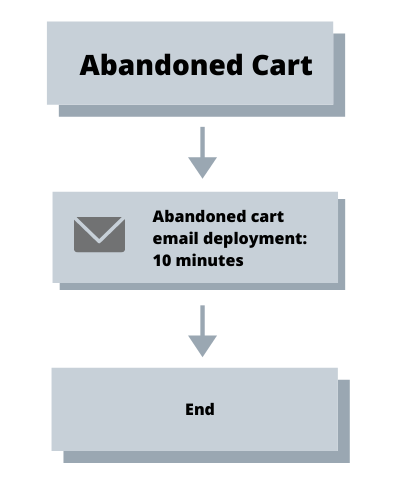
Image Source: Smaily
Cart abandonment emails can also be used to promote related products and make suggestions for other items a customer might be interested in based on the items they have in their cart.
You can also offer incentives such as a discount in your cart abandonment email. However, this strategy can backfire and actually serve to encourage cart abandonment if it becomes widely known as a way to get a discount on your products.
Typically, cart abandonment workflows are short and sweet. One or two reminder emails over a 24 to 48-hour period are enough. If that doesn’t get the customer to convert, additional emails won’t help, and they might prompt the customer to unsubscribe.
5. Survey Workflow
Automation isn’t just for reducing churn or improving conversion, it can also be used for data collection.
One really common example of a survey automation workflow is the automated NPS survey email. Typically, the trigger for an NPS survey is some kind of meaningful interaction with your brand or product. When that happens, the user is sent an automated email with the NPS survey.
Survey workflows can be used in conjunction with email marketing to help with almost any kind of data collection.
For example, want to better understand what users think of a new feature? Create a trigger that sends an automated email with a survey to users who interact with the feature.
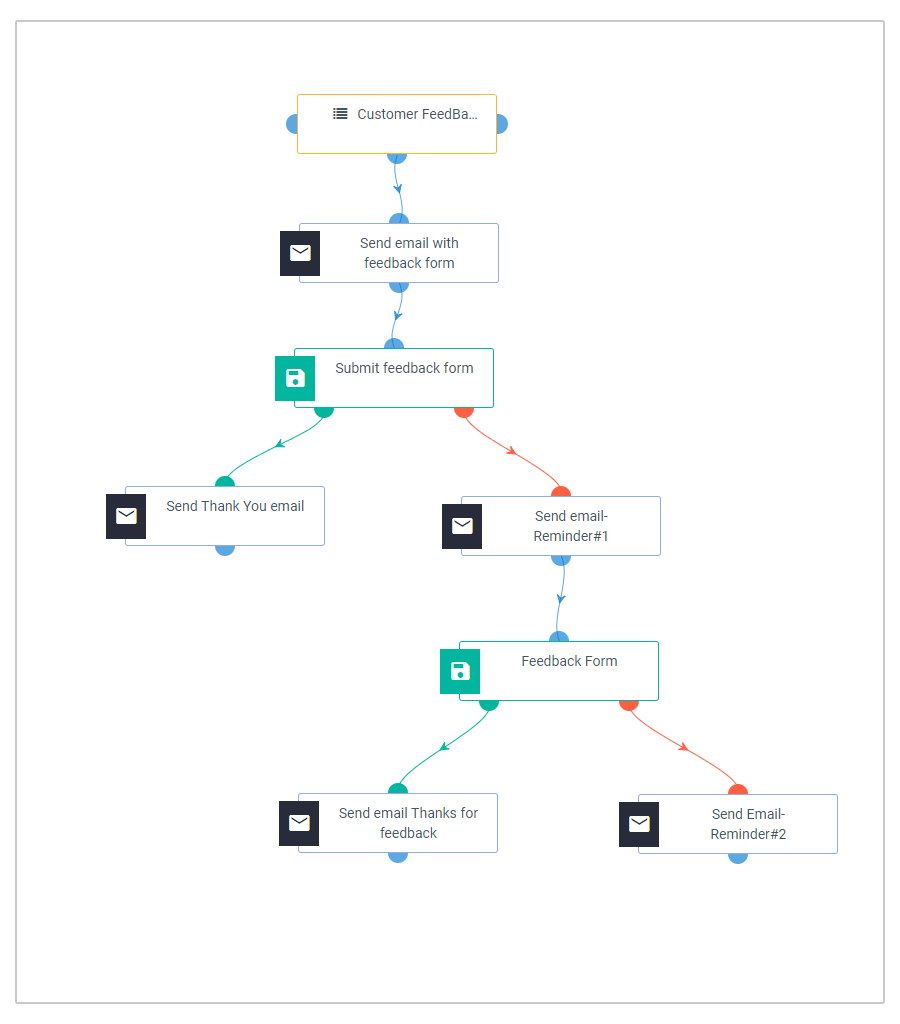 Image Source: Aritic
Image Source: Aritic
Want to know what a particular user demographic thinks about the user experience? Create a conditional trigger that automatically emails a survey to every user who falls into that demographic group.
Want to understand how your customer support team is doing? Use a completed ticket as a trigger to send a “How’d we do?” email that prompts customers for their feedback.
Moving beyond email marketing automation is also possible. Rather than relying on your email list alone, a marketing automation platform could also message customers on social media to solicit feedback if desired.
6. Incentivization Workflow
Ideally, everyone that visits your website will be blown away and excited to make a purchase. In reality, sometimes some people need a little extra incentive before they’re convinced to convert.
Automated incentive workflows can be used to give users who need extra convincing a special incentive, such as a discount, without having to offer that incentive to customers who’ll convert without it.
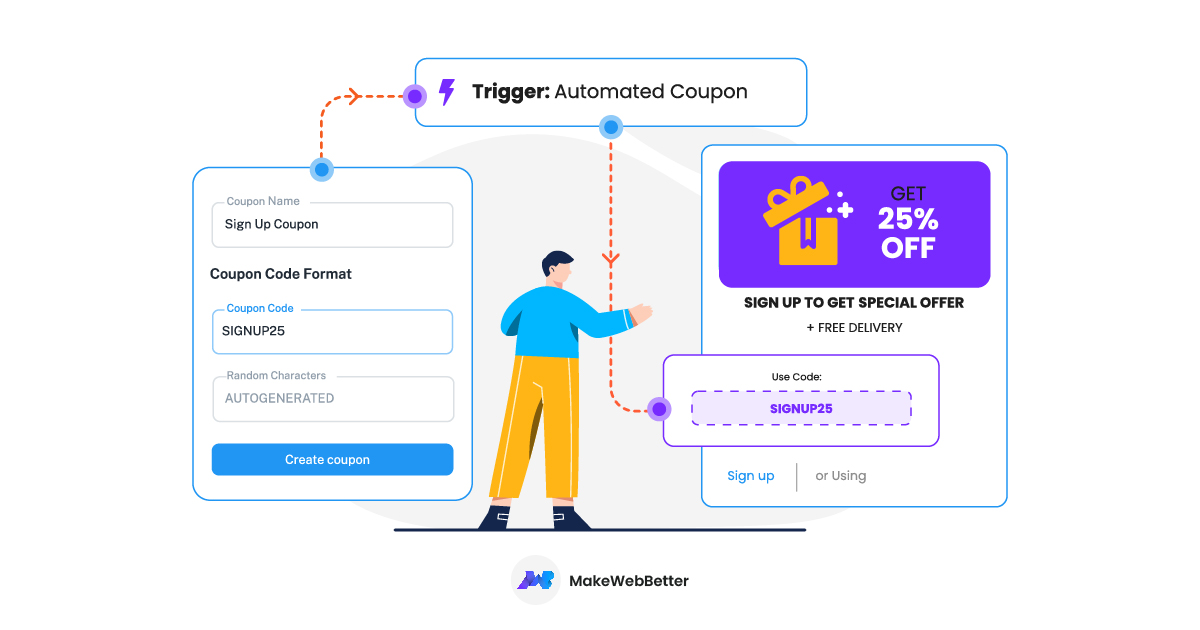 Image Source: MakeWebBetter
Image Source: MakeWebBetter
For example, an eCommerce company with an expensive subscription product might notice that while some users convert right away, others spend a few minutes consuming all of the information on the product page, but ultimately don’t become subscribers.
To convert those users, you could use an automation workflow that is triggered when a user visits that specific page, spends at least three minutes on the page, and then has an “exit intent” scroll (there are many tools available to identify exit intent).
The response to this trigger could be a message (perhaps a pop-up and/or an automated email) offering a time-bound 10% discount. This gives the user a little extra incentive to make their purchase without requiring you to offer a discount to other customers.
7. Gated Content Workflow
Gated content — also sometimes called lead magnets — can be a really effective way to generate leads for your sales team.
At the most basic level, the workflow is quite simple. After your content marketing team has created some kind of long-form, relevant content such as an industry report or whitepaper, users are asked to provide their email in return for a free download.
When they do, automations are triggered that (for example) add their information to Salesforce, perhaps even scoring the lead quality and pinging a salesperson on Slack to follow up.
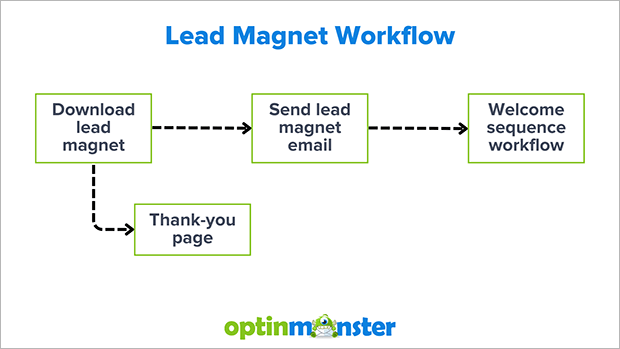
Image Source: OptinMonster
However, it’s also possible to turn a gated content workflow into a full-on lead nurturing workflow that walks the user down your sales funnel and through their customer journey using a series of triggers and responses such as email campaigns.
For example, a customer provides their email to download a guide. This triggers an automated email that invites them to a webinar. If they attend, a salesperson is automatically notified so they can reach out.
If they don’t attend, an automated email sends them the webinar recording. If they engage with it, a salesperson is prompted to reach out — or perhaps another type of content is sent, and the degree to which they engage with that content provides the trigger for the next automation.
Whether that kind of complexity is required really will depend on the specifics of your company and its product.
For B2B companies with complex or highly expensive products, the consideration and purchase process is often lengthy, and having highly complex automated workflows makes sense. For companies with shorter sales funnels, a simpler workflow may be more effective.
8. Recommendation Workflow
Recommendations can be one of the most effective forms of automation. Effective recommendations can make the user feel like they’re getting a bespoke experience that was designed just for them.
At the highest level, a recommendation workflow is often very simple. The trigger might be that the customer purchases a specific product, and the response might be that they’re sent an email promoting a related product.
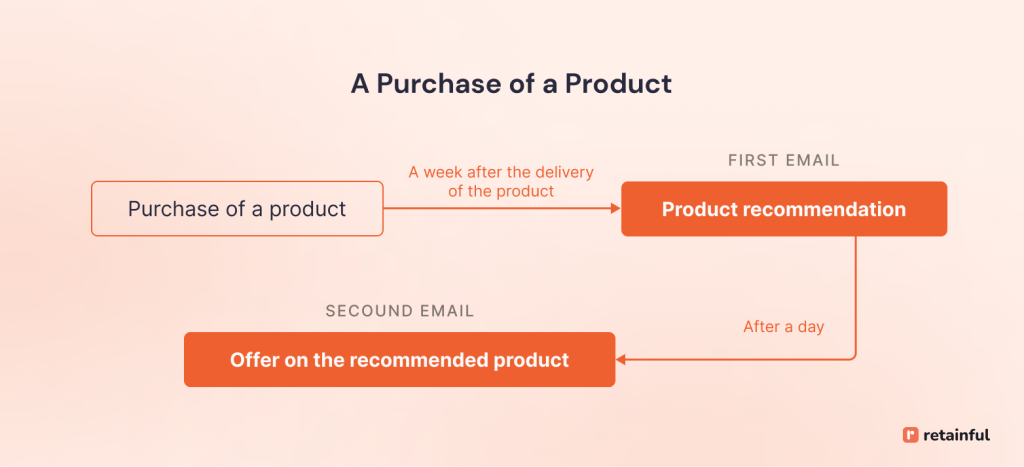 Image Source: Retainful
Image Source: Retainful
Although there might be additional follow-up emails, it’s best to keep this kind of workflow short. If your first email — your best guess at a relevant recommendation— doesn’t convert, you’re likely to have an even lower chance of converting with subsequent recommendation emails.
It’s better to stick to one or two messages with recommendations and if those don’t convert, wait until you’ve collected more or different data about the user before trying again.
(The process of when to send or not send recommendation emails can itself be automated with the right marketing automation software).
So with recommendations, the workflow itself tends to be quite simple. The challenge here isn’t in constructing a complicated logical sequence of marketing emails, it’s in collecting enough data and analyzing it effectively enough to make accurate recommendations.
Ideally, that means choosing a marketing automation tool that integrates some kind of machine learning to generate sophisticated recommendations.
Many companies opt for the easier route of recommending similar items, but this often doesn’t work. For example, if a user has just purchased a computer monitor, sending them an email that recommends three other monitors probably won’t be effective.
9. Subscription Renewal Workflow
Subscription renewal workflow automations are another example of email marketing automation workflows that can be very simple but also very effective.
Generally, the trigger for a renewal email is conditional: a user’s subscription period is ending soon. When a user hits a specific point — for example, ten days before the subscription ends — they’re sent an automated email that prompts them to renew.
This is often followed up with a few additional reminder emails if the customer doesn’t renew after the first one. These emails can be used to remind users of the benefits of your product, and what they’ll be losing if they let their subscription lapse.
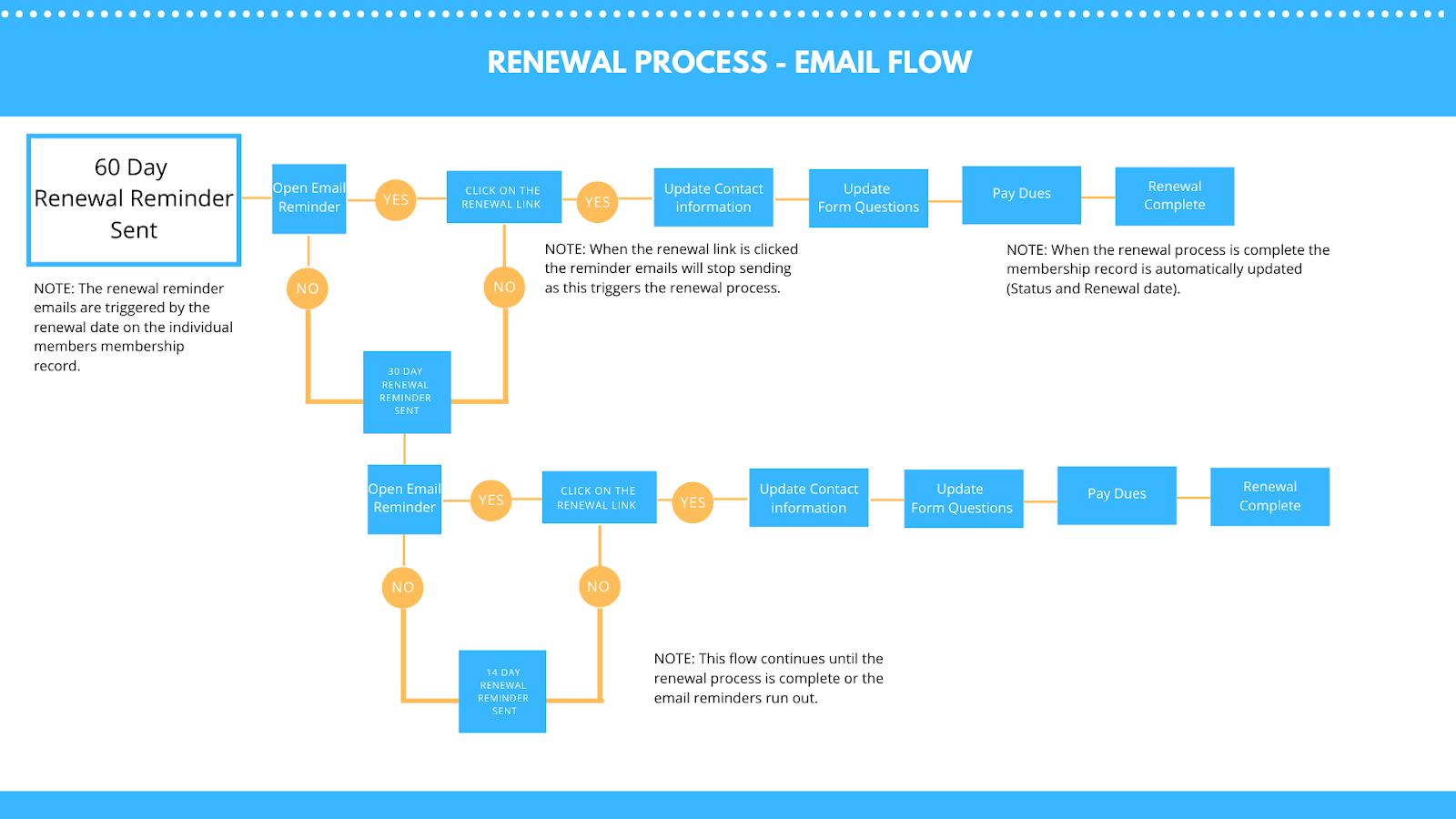 Image Source: Help Desk
Image Source: Help Desk
Often, subscription renewal workflows also include a post-churn email that’s sent to users who fail to renew. This is a we-want-you-back email, and it often offers some kind of incentive — for example, a discount for users who resubscribe.
10. Lead Scoring Workflow
Sales-based businesses succeed or fail based on leads. But in the internet age, leads are a dime a dozen — the challenge is being able to separate the good ones from the bad ones quickly and efficiently. Enter marketing and sales automation tools.
Lead scoring workflows, like many of the workflows on this list, require robust customer data collection. The trigger for lead scoring automation might be something like a signup — perhaps a customer has signed up to download a piece of gated content, for example.
The response is that the automation software will add that lead to Salesforce (for example) with a quality score that’s based on the other data that has been collected about that user.
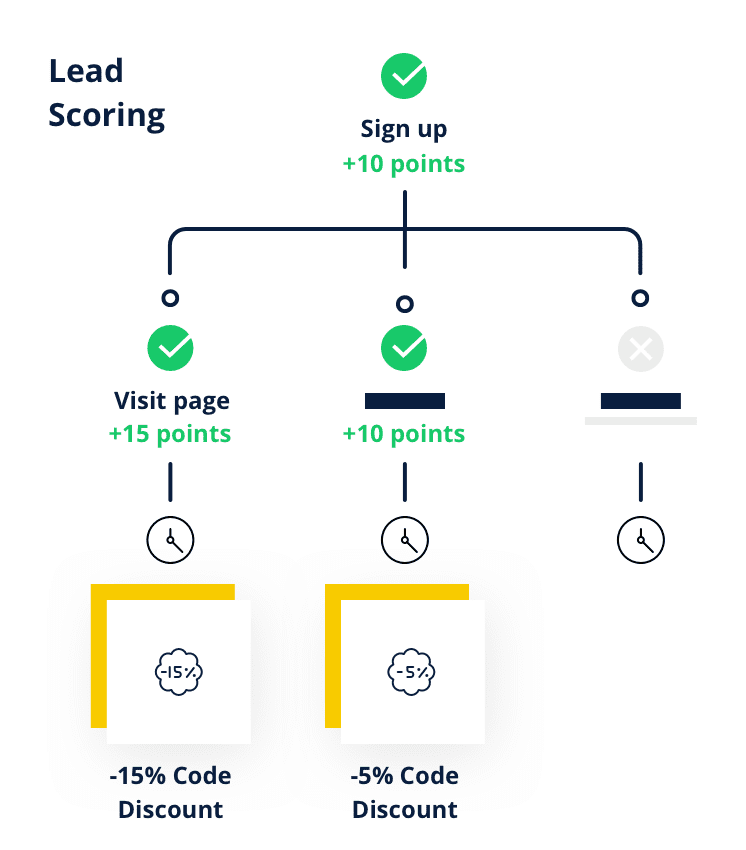 Image Source: Brevo
Image Source: Brevo
That’s why robust data collection is critical — without it, it’s hard to tell a great lead from a waste of time.
Here too, it’s possible to get very sophisticated. Some lead scoring automation tools integrate machine learning to identify the best leads. But lead scoring automation can still be effective even when it’s triggered based on a user matching a human-defined behavior pattern.
If you know what a good lead looks like and you collect enough data to tell the difference, you can use automation to instantly spot, score, and flag high-value leads for your sales team.
11. Communication Workflow
Last but not least, there are many marketing automation workflows that are focused on increasing the efficiency of your teams rather than trying to increase conversions, decrease churn, etc.
A common area for this kind of marketing automation to address is the relationship between your sales team and your marketing team. It’s likely that both are busy, and communication between them can often break down, even though they have useful information for each other.
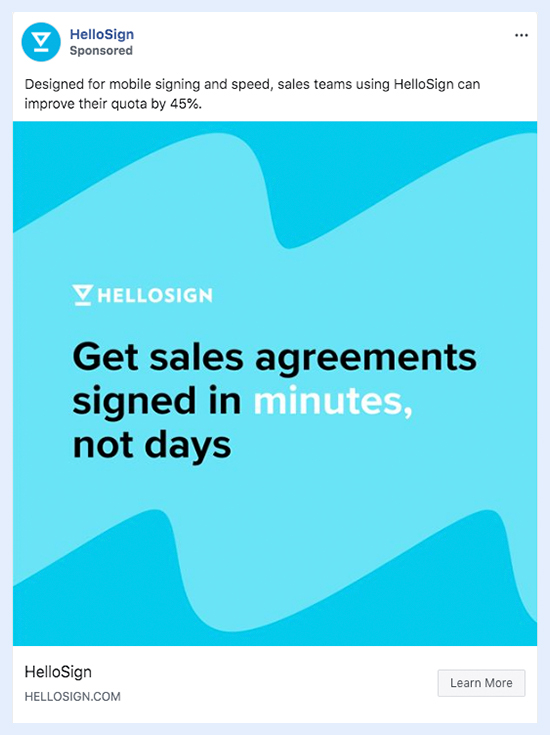
Image Source: Hey Digital
Automation software can ameliorate that by automating the inter-team communication so that neither team has to worry about it.
For example, when a user clicks a digital marketing ad, automation software can automatically check to see if that user is a lead in the sales database and append their entry with information about the ad they were interested in.
Automation software can also use the closing of a deal in sales to trigger sending data to marketing about the various content, ads, and other brand materials the user consumed before the sale was finalized. This can help give the marketing team a clearer idea of what’s working.
What Are Marketing Automation Workflows?
To understand the idea of marketing automation workflows, think about a typical customer’s journey as they move through your B2B marketing funnel (for example).
As they engage with your brand, they will interact with inbound marketing content and take actions that warrant some kind of automated response.
That might mean clicking a button that triggers an email being sent to them. It might mean viewing some content that triggers a notification for your sales team and automatically moves them into a lead nurturing workflow.
A marketing automation workflow describes that sequence of events: what action or actions the user takes, what automation is triggered by those actions, and where things should go from there.
Simple email automation is common, but automation workflows can also be more complex, filtering users into groups and triggering responses based on conditions, calculations, or even predictions from a machine learning algorithm.
The marketing automation workflows you can implement are limited only by your imagination and the capabilities of your automation tools. Even some basic email marketing software can be used to create some sophisticated automated workflows!
In this article, we’ll take a look at some of the most common workflows, including automated email workflows, engagement workflows, customer service workflows, and more.
Key Elements of a Marketing Automation Workflow
All marketing automation workflows, whether they be email marketing workflows, content marketing workflows, or any other kind, share some of the same elements.
- Triggers are the elements that define when an automated action occurs.
- Event-based triggers are actions that a user might take that prompt an automated response. Examples of common triggers are things such as clicking a button, using a product feature, changing their user profile, or changing subscription tiers.
- Conditional triggers are criteria a user meets that prompt an automated response. Examples of conditions that could be used in this way are things such as being part of a specific user segment or demographic, having viewed a specific piece of content in the past, etc.
- *Responses *are the elements that define what happens when a trigger or condition is met. Or, in other words, when a user activates a trigger or meets a condition, whatever happens is the response.
In some cases, the response entails direct communication with the user. Email automation is a good example of this: When a trigger is fired or a condition is met, the response is an email being sent.
But it doesn’t have to be through email, other direct communication responses, such as a popup banner or a chatbot window, could also be triggered.
In other cases, the response might be less apparent to the user: a trigger might lead to a notification in Slack to the sales team about a new potential lead in the sales funnel.
It could even pass a user's data to digital marketing tools to target them with remarketing ads on social media.
Again, there are no real limits here – with the right automation software and the right data collection, you can work with almost any triggers and conditions you choose, and your responses can be almost anything.
Final Thoughts
Of course, these are all just examples. When it comes to marketing automation workflows there’s room for almost infinite variation and complexity, and a solution that’s right for one company may not be right for another.
While some companies see success with email marketing and lean on email automation workflows to bring in new subscribers, others may get more mileage out of using automations to boost their internal team’s efficiency and communication.
However, every company can benefit from making use of some sort of marketing automation.



